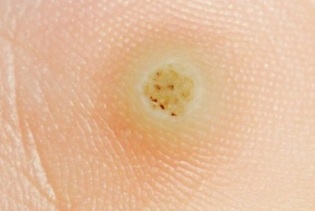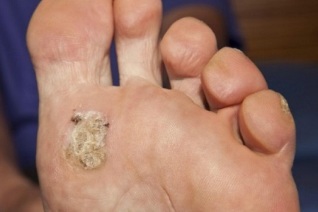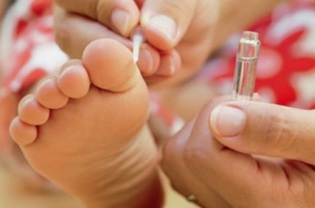
If you see a hard and rough papule with a rough surface on the soles of the feet, it is either a plantar wart or a callus. The differences are primarily important in the origin and treatment methods. The wart grows like a sharp thorn on the inner layer of the skin of the foot, which causes severe pain. Doctors recommend removing this swelling if the shoe is damaged and inflamed.
Appearance of growth on the sole of the foot
The main part of the common wart on the foot grows inwards, towards the dermis. The reason is that from the outside the tumor is compressed by hard surfaces: shoes, various coatings we walk on. New growth cells form from the soft tissue of the skin. A photograph of a plantar wart shows a dense plaque or roll on the outside. The surface of the form is devoid of skin lines, consists of scales of horny substance. Adjacent skin changes: it becomes denser, covered with a layer of keratin.
What does a plantar wart look like:
- a nodule or plaque 1-5 mm above the epidermis;
- image is round, oval or polygonal;
- surface is hard and rough to the touch;
- color pink, yellow-white or gray;
- formation diameter between 1 and 20 mm;
- no papillary pattern; The
- edges are well defined.
Warts on the legs are characterized by severe pain that prevents them from walking until they become temporarily disabled.

Accumulation occurs in areas exposed to intense pressure and perspiration. Typical localization of the wart on the sole: heels, pads and toes. Painful and difficult to remove formations appear on the edge of the nail and under the nail plate. Inside all types of warts, there are blood vessels that nourish living tissues, and cells that multiply intensively. Small black dots appear on the surface - blood clots in the capillaries; may bleed when the corneal layer is cut.
Plantar warts are most common in school-age children. In about 30% of patients, such formations disappear spontaneously during the first year. However, it is recommended to start treatment when the first symptoms appear, especially if the plantar wart is painful or there is a high risk of infection in the surrounding people. Infection is also dangerous, when a group of formations appear in one area, individual papules merge into a mosaic plate.
wart - papilloma virus
ManifestationThe skin on the feet is often damaged, squeezed and sweaty when wearing tight and uncomfortable shoes. If thin-walled bubbles with a clear liquid appear, they are corns. Sometimes a layer of keratin forms on the surface, however, typical skin lines remain.
Initially, the appearance of a wart under the foot goes unnoticed or is thought to be the formation of a callus. It is necessary to look carefully at the surface of the formation and pay attention to the characteristic features. This is severe keratinization, lack of skin lines, pain when the surrounding skin is compressed. These are the results of the active multiplication of the papilloma virus in living cells of the epithelium.
Causes of plant warts:
- papilloma virus (HPV) infection;
- weakening of local and general immune defenses;
- virus activation, penetration into epithelial cells;
- increased proliferation and rapid keratinization of infected cells.
HPV is transmitted through home and sexual contact. Infectious substances penetrate the skin and mucous membranes with minor damage: cracks, cuts, crying.
Type 1, 2, 4, 27 and 57 papilloma viruses are mainly transmitted to cells located in the skin of the feet. Plant species of viral origin belong to simple formations (ordinary, vulgar). According to the International Classification of Diseases, these are infectious and parasitic diseases. ICD-10 class: "Viral infections characterized by damage to the skin and mucous membranes. "
Simple warts are benign epithelial tumors. They do not pose a threat to health in the beginning. Sometimes such growths become malignant in a cancerous tumor. The process is triggered by HPV types, which are more likely to develop cancer.
Foot wart treatment
After infection, the incubation period begins: the papilloma virus invades the cells, "reformatting" their proliferation and development. Very often, the infection is latent and can persist throughout the life of the organism in such a dormant state. In this case, the immune system suppresses the papilloma virus and goes to sleep without special therapy.
Plantar warts may appear after 3 to 10 years or a few weeks after infection, then disappear within the first year or two.
Not everyone is ready to wait, hoping that the skin will heal spontaneously and grow. Many people see a doctor at the first sign of an HPV infection. Dermatologists recommend the use of modern methods to clean warts, antiviral therapy, strengthening the immune system of the skin and the whole body.
If it is necessary to determine the type of HPV for an appropriate therapy option, the doctor will prescribe several additional tests. A biopsy is performed to collect histological material, and an analysis is performed to determine antibodies to the papilloma virus.

Treatment options:
- Use of special drugs for plantar warts. Dead cells melt and erode.
- Simple neoplasms are treated with laser removal and itching. The crust disappears 7-10 days after the procedure.
- Cryodesy with liquid nitrogen. Large warts are removed in several procedures. When exposed to low temperatures, a bubble appears as it does after a burn.
- Electrocoagulation using an electrode in which a high-frequency current is applied to destroy pathological tissue. A painful procedure accompanied by a strong odor on the skin.
- Surgical removal.
- Drug injection.
It is recommended to use a special plaster at home at the beginning of treatment. This convenient tool is used after softening the warts on the feet with warm water and removing keratinized layers using nail scissors and pumice. Then apply a patch. The course of treatment lasts an average of 1-3 months.
Prevention
Papilloma viruses can persist in the environment for a long time. Feet should be kept clean, do not go barefoot, especially in public locker rooms, bathrooms, swimming pools. Special slippers should be used to protect the soles of the feet from contact with surfaces contaminated with other people's skin particles. Also, do not wear other people's socks and shoes.
Do not scratch the wart, otherwise similar growths will appear on other parts of the leg.
Papilloma viruses are extremely contagious. Disinfect accessories for daily hygiene and medication applications. Socks and towels should be washed thoroughly with warm water, scissors, nail file, pumice stone should be disinfected. Wash your hands with soap and water after touching education and various medical procedures.















































































